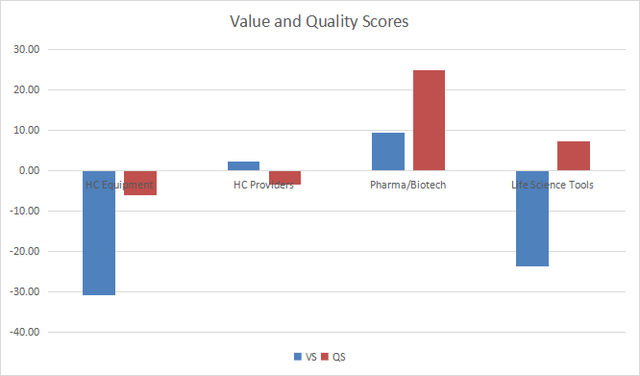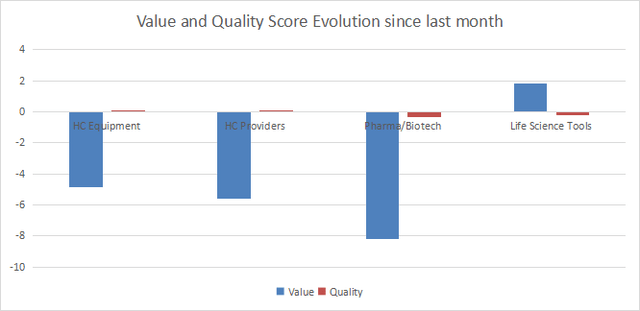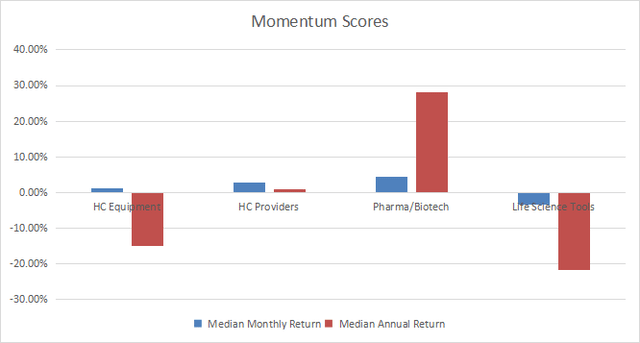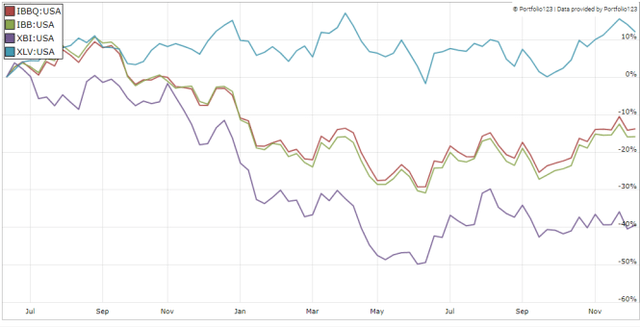ktsimage
This monthly article series shows a dashboard with aggregate industry metrics in healthcare. It may also serve as a top-down analysis of sector ETFs like the Health Care Select Sector SPDR ETF (XLV) and other healthcare funds, whose largest holdings are used to calculate these metrics.
Shortcut
The next two paragraphs in italic describe the dashboard methodology. They are necessary for new readers to understand the metrics. If you are used to this series or if you are short of time, you can skip them and go to the charts.
Base Metrics
I calculate the median value of five fundamental ratios for each industry: Earnings Yield (“EY”), Sales Yield (“SY”), Free Cash Flow Yield (“FY”), Return on Equity (“ROE”), Gross Margin (“GM”). The reference universe includes large companies in the U.S. stock market. The five base metrics are calculated on trailing 12 months. For all of them, higher is better. EY, SY and FY are medians of the inverse of Price/Earnings, Price/Sales and Price/Free Cash Flow. They are better for statistical studies than price-to-something ratios, which are unusable or non available when the “something” is close to zero or negative (for example, companies with negative earnings). I also look at two momentum metrics for each group: the median monthly return (RetM) and the median annual return (RetY).
I prefer medians to averages because a median splits a set in a good half and a bad half. A capital-weighted average is skewed by extreme values and the largest companies. My metrics are designed for stock-picking rather than index investing.
Value and Quality Scores
I calculate historical baselines for all metrics. They are noted respectively EYh, SYh, FYh, ROEh, GMh, and they are calculated as the averages on a look-back period of 11 years. For example, the value of EYh for healthcare providers in the table below is the 11-year average of the median Earnings Yield in this industry.
The Value Score (“VS”) is defined as the average difference in % between the three valuation ratios (EY, SY, FY) and their baselines (EYh, SYh, FYh). The same way, the Quality Score (“QS”) is the average difference between the two quality ratios (ROE, GM) and their baselines (ROEh, GMh).
The scores are in percentage points. VS may be interpreted as the percentage of undervaluation or overvaluation relative to the baseline (positive is good, negative is bad). This interpretation must be taken with caution: the baseline is an arbitrary reference, not a supposed fair value. The formula assumes that the three valuation metrics are of equal importance.
Current data
The next table shows the metrics and scores as of last week’s closing. Columns stand for all the data named and defined above.
|
VS |
QS |
EY |
SY |
FY |
ROE |
GM |
EYh |
SYh |
FYh |
ROEh |
GMh |
RetM |
RetY |
|
|
HC Equipment |
-30.93 |
-5.99 |
0.0247 |
0.2321 |
0.0156 |
11.27 |
67.41 |
0.0329 |
0.2768 |
0.0323 |
13.81 |
63.32 |
1.19% |
-15.03% |
|
HC Providers |
2.36 |
-3.33 |
0.0486 |
1.4219 |
0.0723 |
17.69 |
20.02 |
0.0525 |
1.4334 |
0.0627 |
15.92 |
24.36 |
2.70% |
0.88% |
|
Pharma/Biotech |
9.39 |
24.98 |
0.0460 |
0.2055 |
0.0417 |
32.30 |
79.04 |
0.0373 |
0.2468 |
0.0343 |
21.26 |
80.67 |
4.34% |
28.15% |
|
Life Science Tools |
-23.62 |
7.40 |
0.0289 |
0.1785 |
0.0217 |
17.16 |
59.02 |
0.0298 |
0.2872 |
0.0310 |
15.92 |
55.15 |
-3.50% |
-21.77% |
Value and Quality chart
The next chart plots the Value and Quality Scores by industry (higher is better).
Value and quality in healthcare (Chart: author; data: Portfolio123)
Evolution since last month
The value score has deteriorated in all subsectors, except life science tools.
Score variations (Chart: author; data: Portfolio123)
Momentum
The next chart plots momentum data.
Momentum in healthcare (Chart: author; data: Portfolio123)
Interpretation
Pharmaceuticals/biotechnology has been the best-ranked healthcare subsector for many months, regarding both value and quality scores. Healthcare providers look good: they are close to 11-year averages in aggregate valuation and quality metrics. Healthcare equipment and life science tools are overvalued by more than 20% relative to the historical baseline. It may be partly justified by a good quality score for life science tools.
Focus on IBBQ
Biotechnology is the most promising industry in the sector. The Invesco Nasdaq Biotechnology ETF (NASDAQ:IBBQ) has been tracking the Nasdaq Biotechnology Index since 06/11/2021. For investors seeking exposure to biotech companies, it is an alternative to the iShares Biotechnology ETF (IBB), which tracks the ICE Biotechnology Index, or to the SPDR S&P Biotech ETF (XBI), which tracks the S&P Biotechnology Select Industry. The expense ratio of IBBQ is 0.19%: it is cheaper than IBB (0.44%) and XBI (0.35%), but more expensive than the broad sector fund XLV (0.10%).
As defined in the prospectus by Invesco, eligible stocks must:
– be classified in biotech or pharma in the ICB classification,- have a minimum market capitalization of $200 million,- have a minimum average daily trading volume of 100,000 shares.
IBBQ hold 273 stocks, mostly of U.S. companies (about 90% of asset value). The portfolio is very concentrated: the aggregate weight of the top 10 holdings is 52.9% (list below).
|
Ticker |
Name |
Weight (%) |
EPS growth% |
P/E ttm |
P/E fwd |
Yield% |
|
Gilead Sciences, Inc. |
8.06 |
-54.90 |
32.81 |
12.25 |
3.37 |
|
|
Amgen, Inc. |
7.62 |
28.55 |
21.43 |
15.13 |
3.19 |
|
|
Vertex Pharmaceuticals, Inc. |
7.32 |
52.16 |
24.06 |
20.82 |
0 |
|
|
Regeneron Pharmaceuticals, Inc. |
7.24 |
-24.26 |
15.25 |
16.77 |
0 |
|
|
Moderna, Inc. |
6.94 |
69.84 |
6.99 |
8.72 |
0 |
|
|
AstraZeneca PLC |
3.88 |
3.18 |
103.19 |
20.10 |
2.13 |
|
|
Biogen, Inc. |
3.81 |
92.04 |
14.52 |
16.69 |
0 |
|
|
Illumina, Inc. |
2.94 |
-535.27 |
N/A |
81.11 |
0 |
|
|
Alnylam Pharmaceuticals, Inc. |
2.73 |
-37.02 |
N/A |
N/A |
0 |
|
|
Horizon Therapeutics Plc |
2.39 |
4.75 |
46.41 |
23.84 |
0 |
Since inception in June 2021, IBBQ has outperformed XBI by over 25 percentage points in total return. It is shortly ahead of IBB, but lags XLV by far.
IBBQ vs IBB, XBI, XLV (Portfolio123)
IBBQ is a good fund with cheap management fees to invest in biotechnology for the long-term. However, trading volumes are thin: it is not suitable for swing trading or tactical allocation. Anyway, using limit orders is always recommended.
Dashboard List
I use the first table to calculate value and quality scores. It may also be used in a stock-picking process to check how companies stand among their peers. For example, the EY column tells us that a large pharma/biotech company with an Earnings Yield above 0.0460 (or price/earnings below 21.74) is in the better half of the industry regarding this metric. A Dashboard List is sent every month to Quantitative Risk & Value subscribers with the most profitable companies standing in the better half among their peers regarding the three valuation metrics at the same time. The list below was sent to subscribers several weeks ago based on data available at this time.
|
Vir Biotechnology, Inc. |
|
|
Dynavax Technologies Corp. |
|
|
Ironwood Pharmaceuticals, Inc. |
|
|
DaVita, Inc. |
|
|
Pfizer Inc. |
|
|
Innoviva, Inc. |
|
|
Molina Healthcare, Inc. |
|
|
Zynex, Inc. |
|
|
QuidelOrtho Corp. |
|
|
Organogenesis Holdings, Inc. |
It is a rotating list with a statistical bias toward excess returns on the long-term, not the result of an analysis of each stock.


Be the first to comment